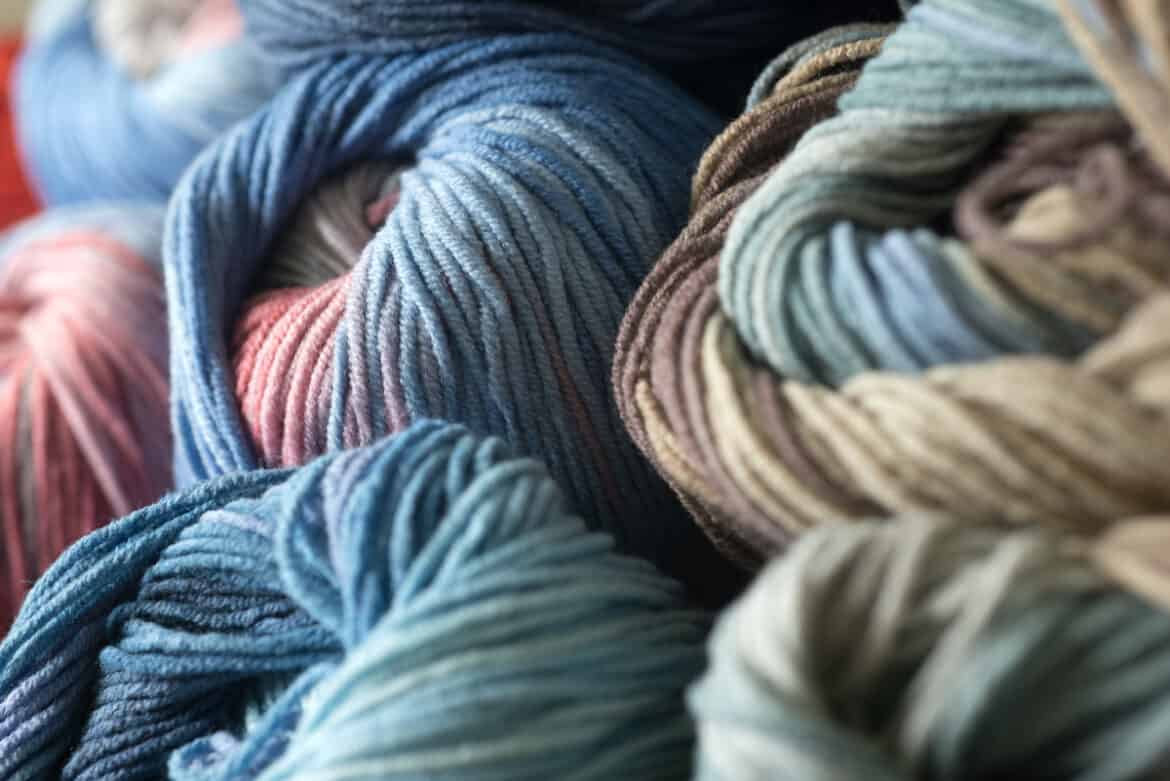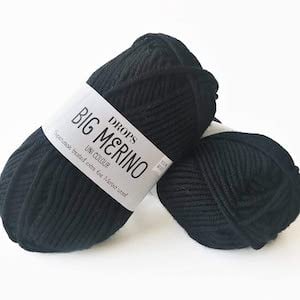Worsted and Aran are two terms that often get mixed up. Both terms refer to medium-weight yarn that has very similar looks, but did you know that they’re actually two different yarn weights?
What’s the difference between Aran vs worsted yarn? Worsted weight yarn is thinner than Aran yarn. Both are medium-weight yarns and can be used interchangeably in most knitting patterns using 4.5-5mm needles.
Since these are two of the most widely used yarn weights for knitters and crocheters, let’s take a look at the differences between these two different yarn weights and find out what the best applications are for them.
The Differences Between Worsted Yarn and Aran Yarn
Even though worsted yarn and Aran yarn are both considered medium-weight yarns, there are a couple of slight differences between the two. Let’s take a look at how yarn weight, recommended needle size, and gauge differs between these two yarns.
Yarn Weight
If you’re unfamiliar with the term “yarn weight,” no, it doesn’t refer to the actual weight of the yarn. The term refers to the thickness of the individual strand of yarn. Yarn weight ranges from very fine, lace-weight yarn to super chunky yarn.
Knowing the yarn weight for your project is important because it will decide the needle size you will need to use and how fine or chunky your stitches will look.
The reason Aran and worsted weight yarn are often confused together is that both of them are medium-weight yarns that can be used with 4-5mm knitting needles or crochet hooks. They look very similar to one another and are often interchangeable in a lot of knitting patterns.
However, on a technical level, worsted weight yarn is slightly thinner than Aran weight yarn. Worsted-weight yarn is usually recommended to use with 4-4.5mm needles, while Aran weight yarn is usually recommended to use with 5-5.5mm.
When you have a worsted-weight yarn ball and an Aran-weight yarn ball, it may be difficult to compare the two. However, if you take a look at the individual strands, you may be able to tell that worsted weight yarn is slightly finer than Aran yarn.
To make matters more confusing, in the UK, “Aran” is the blanket term for all medium-weight yarn, including worsted-weight yarn. So if you live in the UK, you may not have a lot of luck finding worsted-weight yarn in the craft store. Instead, you will need to opt for Aran yarn for your project.
Yarn Weight Vs Yarn Ply
Yarn ply refers to how many individual plies of yarn are twisted together to create the single strand of yarn that you can use to knit your project.
Yarn ply used to be the same as yarn weight because previously in yarn production, the ply used to have the same weight across the board, so a 2-ply yarn would indicate a lace-weight yarn, while a 20-ply yarn would be super chunky.
However, that’s no longer the case with modern-day production, as yarn ply now varies in weight, so you can have a lace-weight yarn that is 10-ply or a chunky yarn that is single ply.
Why are we talking about yarn ply in a conversation about yarn weight? Well, that’s because although this unit of measurement is now outdated, a lot of yarn types still use ply to indicate yarn weight.
For example, Aran yarn is still referred to as a 10-ply yarn sometimes, even if the yarn itself is single-ply!
So, if you are looking for Aran yarn or worsted weight yarn but cannot find it in the craft store, you may have better luck referring to 10-ply yarn, which will indicate a medium-weight yarn.
Needle Size
If you have difficulties telling the differences between worsted weight yarn and Aran yarn, then you’re definitely not alone. Even experienced knitters and crocheters sometimes confuse the two.
If the names of the yarn weights are too confusing to you, the safer bet would be to take a look at the recommended needle size on the sleeve of the yarn.
This is because the needle size correlates with the yarn weight – the thicker the yarn, the bigger your knitting needles or crochet hook will need to be.
The sleeve of the yarn ball will also tell you the gauge that you can achieve with the yarn and the needle size, which will help you find the best yarn for your project. We will talk more about gauge in a minute.
As we’ve mentioned, worsted weight yarn is usually recommended to use with 4.5mm knitting needles, while the Aran yarn is usually recommended to use with 5mm knitting needles. So, if you can’t tell which is which, take a look at the recommended needle size in your pattern and find the yarn weight with the same recommended needle size.
However, needle size is only a guide, not a requirement. Experienced knitters and crocheters can have fun playing around with the needle size because it will help them achieve different looks for their projects.
Worsted weight yarn is usually recommended with 4.5mm needles, but you can use a smaller needle size for tighter stitches, which are good for projects like hats and gloves. With bigger needles, you can achieve a loose-knit effect, which is great for shawls and blankets.
In this sense, Aran and worsted weight yarn can be interchangeable, especially if you use the same needle size as recommended by your pattern.
Keep in mind that since worsted weight yarn is slightly thinner than Aran yarn, using bigger needles – say, 5mm – may create a loose-knit effect. However, the difference may not be very noticeable, especially if you have a very textured worsted-weight yarn.
Gauge
Let’s talk a little bit about gauge because it is arguably the most important factor that will decide how your final project will look.
Because you can play around with the yarn and needle size for every project, using the correct gauge is important, especially if you need to achieve a certain size for a sweater or blanket.
Gauge refers to the size you can achieve with a certain number of stitches and a certain number of rows. The recommended gauge is always indicated on the sleeve of a ball of yarn. For example, it can say a 10” x 10” square is achieved by using 4.5mm needles while knitting 45 stitches and 30 rows.
Gauge is always measured after blocking, so don’t worry if your gauge swatch looks a little wonky at first. Blocking refers to the process of wetting and pinning a knitted or crocheted piece in place so that your garment can take its proper form.
If you decide to play around with the yarn weight and the needle size, it is very important to knit or crochet a gauge swatch to determine how many stitches and rows you need to have to create a certain size.
This is especially important if you are knitting or crocheting a garment that you will be wearing, like a sweater or hat, because the correct gauge will help your final garment hug your body comfortably.
To measure gauge, use your yarn and your needles to knit a 20 stitch by 20 row rectangle. After blocking this gauge swatch, you can measure how many stitches and how many rows are in a 1” x 1” square and use this measurement to see how many stitches to cast on for your project.
If you are using the yarn and needle size recommended by the pattern, and the needle size matches the recommended size for the yarn, you can skip the gauge swatch because that has already been indicated on the sleeve of the yarn.
Best Projects For Medium-Weight Yarn
Both worsted weight yarn and Aran yarn are universally beloved because they are both medium-weight yarns that can work on a number of projects. This is my favorite Aran yarn to use for sweaters, mittens, and hats.
It’s important to use the correct swatch recommended by the yarn brand, so the stitches are not too tight or too loose, which will make the garment more comfortable, and you can conveniently skip the gauge swatch steps.
When knitting garments that you want a bit of drape, such as scarves, shawls, and blankets, you can use bigger needles for looser stitches. Using bigger needles will also make knitting a completed project much faster.
For projects that need to have tighter stitches, such as potholders, mats, or mittens, you can use smaller needles than the recommended size.
Keep in mind that the smaller needles may make knitting slower, and we only recommend going one size smaller because otherwise, the stitches may be too tight and uncomfortable to knit.
Additional Tips
As you can see, you can use Aran yarn and worsted weight yarn interchangeably on a number of projects, but make sure to use the following tips to get the best result:
- If you are unsure about the yarn weight, take a look at the sleeve of the yarn ball to find the recommended needle size. Usually, a needle size of 4.5-5mm indicates a medium-weight yarn.
- Working with a smaller or bigger needle size than the recommended size will affect how tight or lose your stitches will be.
- If you are using a needle size different from the recommended size, it’s important to knit a gauge swatch and measure the size after blocking to find out how many stitches to cast on to achieve the desired size.
Up Next: Cheapest Yarn – How To Find The Best Deals

